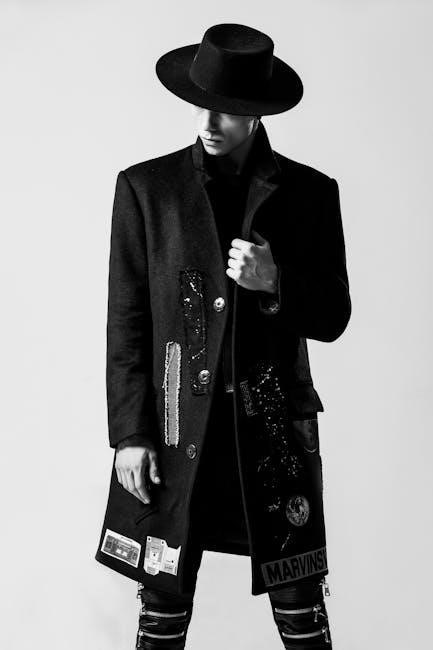Understanding men’s jacket sizing is crucial for a perfect fit, ensuring comfort and style. Proper sizing considers chest, shoulder, and body measurements, guiding you to the ideal jacket size.
Why Proper Sizing Matters for Men’s Jackets
A well-fitted jacket is essential for both style and comfort. Proper sizing ensures the jacket sits naturally on the body, allowing for a full range of motion while maintaining a sharp, polished appearance. A poor fit can lead to restricted movement, an unflattering silhouette, or a jacket that looks too tight or overly bulky. Investing in the right size enhances confidence and ensures the jacket performs its intended function, whether for casual wear or formal occasions. It also accommodates layering during colder months, making it a practical and versatile addition to your wardrobe.
Key Considerations for Choosing the Right Jacket Size
When selecting a jacket, it’s important to prioritize a balance of comfort and aesthetics. Consider your body type, as slimmer fits suit lean builds while relaxed styles accommodate broader frames. Additionally, think about the purpose of the jacket—whether it’s for layering, formal events, or casual wear. Fabric thickness and intended use also influence sizing, as bulkier materials may require a slightly larger size. Lastly, check the size charts of different brands, as measurements can vary, and consider personal preferences for fit, whether you prefer a snug or roomier feel. This ensures the jacket meets both functional and fashion needs.

Understanding Jacket Measurements
Accurate jacket measurements are crucial for a perfect fit, focusing on chest, shoulder, sleeve length, and body length to ensure comfort and style.
How to Measure Your Chest for a Jacket
To measure your chest for a jacket, wrap a flexible tape measure around the widest part of your chest, typically at nipple level.
Ensure the tape is horizontal and not too tight or loose.
Stand up straight and relax your arms at your sides for an accurate reading.
This measurement is crucial for determining your jacket size and ensuring a comfortable fit.
If you’re unsure, consider having someone assist you for precision.
Remember, this measurement is the foundation for choosing the right jacket size.
How to Measure Your Shoulder for a Jacket
To measure your shoulder for a jacket, place the tape measure across the back of your shoulders, starting from the tip of one shoulder to the tip of the other.
Ensure the tape is level and parallel to the floor, with your arms relaxed at your sides.
This measurement helps determine the jacket’s shoulder fit, which is essential for both style and comfort.
Stand up straight and avoid slouching to get an accurate reading.
If possible, have someone assist you to ensure the tape stays in place.
This measurement is vital for ensuring the jacket sits properly on your frame.
How to Measure Sleeve Length for a Jacket
To measure sleeve length for a jacket, stand up straight with your arms relaxed by your sides.
Place the tape measure at the center back of your neck, just below the base of the skull.
Bring the tape down over your shoulder, following the natural curve of your arm, and end at the wrist bone.
This measurement ensures the sleeves will be the correct length for your frame.
If you’re measuring for a fitted jacket, consider bending your elbow slightly to account for movement.
For accuracy, use a jacket you already own and like the fit of as a reference.
This step is crucial for achieving a balanced and comfortable fit.

How to Measure Body Length for a Jacket
Measuring body length for a jacket involves determining the length from the base of the neck to the desired jacket hem.
Stand up straight and place the tape measure at the center back of your neck, just below the collarbone.
Bring the tape down vertically along your spine, ending at the point where you want the jacket to end, typically at the hip or waistline.
For most jackets, this is about 2-3 inches below the waist.
Ensure the tape is parallel to the floor and not angled for accuracy.
If using a reference jacket, measure from the collar to the hem to match the fit.
This ensures the jacket sits comfortably without being too short or too long.
Avoid measuring over bulky clothing for precise results.
This measurement is key to achieving a balanced and flattering fit.

Types of Jacket Fits
Jacket fits vary to suit different body types and styles, offering slim, regular, relaxed, and oversized options to ensure comfort and fashion preferences are met perfectly.
Slim Fit Jackets: Features and Who They Suit
Slim Fit Jackets: Features and Who They Suit
Slim fit jackets are tailored to create a contemporary, streamlined look, fitting closely to the body without restricting movement. They feature narrower shoulders, a tapered waist, and shorter lengths, emphasizing a modern aesthetic. Ideal for men with lean or athletic builds, slim fit jackets accentuate a defined physique. They are perfect for formal or semi-formal occasions, offering a sharp, polished appearance; However, they may not be suitable for those with broader frames or who prefer a looser fit. Pairing slim fit jackets with slim trousers or chinos completes the stylish, cohesive look they are designed to achieve.
Regular Fit Jackets: Characteristics and Benefits
Regular fit jackets offer a classic, timeless style with a balanced fit that is neither too tight nor too loose. They are designed to accommodate a wide range of body types, making them a versatile choice for most men. The jacket skims the body, providing ease of movement while maintaining a polished appearance. Regular fit jackets are ideal for casual or semi-formal occasions, offering comfort and practicality. They can be easily layered over sweaters or dress shirts, making them a reliable option for everyday wear. Their universal appeal and adaptability ensure they remain a staple in many wardrobes, suitable for both relaxed and slightly dressier settings.
Relaxed Fit Jackets: When to Choose This Style
Relaxed fit jackets are designed for comfort and ease, offering a looser silhouette compared to slim or regular fits. They are ideal for men who prefer a casual, laid-back look or need extra room for layering. This style is perfect for taller or broader individuals, as it provides ample space across the chest and shoulders. Relaxed fit jackets are great for everyday wear, outdoor activities, or layering over thick sweaters. They strike a balance between practicality and style, making them a versatile option for men who prioritize comfort without sacrificing a polished appearance. This fit is particularly suited for relaxed, informal settings where ease of movement is key.
Oversized Fit Jackets: Fashion and Functionality
Oversized fit jackets are a bold fashion statement, offering a loose, comfortable silhouette. They are designed to be worn over layers, making them ideal for colder weather or creating a stylish, layered look. This fit is perfect for those who want a relaxed, casual appearance while maintaining a fashionable edge. Oversized jackets often feature dropped shoulders and a boxy shape, adding a modern touch to any outfit. They are versatile and can be dressed up or down, depending on the occasion. This style is particularly popular among fashion-conscious individuals who appreciate both comfort and trendiness. Oversized jackets are a great choice for making a statement while staying warm and comfortable.

How to Measure Yourself for a Jacket
Measure your chest, shoulders, sleeve length, and body length using a flexible tape measure. Ensure accurate measurements for the best fit, keeping the tape level and snug.
Step-by-Step Guide to Measuring Your Jacket Size
To measure your jacket size accurately, start by wrapping a flexible tape measure around your chest at nipple level, keeping it level and snug but not tight. Next, measure your shoulders from one shoulder tip to the other, ensuring the tape is straight. For sleeve length, measure from the center back of your neck, over your shoulder, and down to your wrist. Finally, measure your body length from the base of your neck down to your hipbone. Use these measurements to compare with a size chart, ensuring the best fit for comfort and style. Always measure over lightweight clothing for accuracy.
Using a Jacket You Already Own as a Reference
If you already own a jacket that fits well, it can be a great reference for determining your size. Lay the jacket flat on a smooth surface and measure its chest width, shoulder length, and sleeve length. Compare these measurements to the size chart of the jacket you’re interested in buying. Ensure the measurements align closely to guarantee a similar fit. This method saves time and reduces guesswork, especially when shopping online. Pay attention to fabric thickness, as it may affect how the jacket drapes. Using a well-fitting jacket as a guide helps you choose the right size confidently, ensuring comfort and style.

Factors Affecting Jacket Fit
Body type, fabric thickness, layering, and brand sizing variations all influence jacket fit. These factors ensure comfort, style, and functionality, making proper measurements and size selection crucial.
Body Type and Jacket Fit: What to Look For
Understanding your body type is essential for selecting a jacket that flatters your frame. Slim men should opt for tailored fits to avoid overwhelming their physique, while broader or athletic builds benefit from structured styles that balance proportions. Taller individuals may require longer sleeves and body lengths, ensuring the jacket doesn’t appear too short. Conversely, shorter men should avoid oversized styles, as they can overwhelm the frame. Consider your shoulder width, chest size, and torso length when choosing a fit. Additionally, layering preferences and fabric thickness impact how a jacket sits on your body, making it crucial to align these factors with your unique silhouette for optimal comfort and style.
Fabric Thickness and How It Impacts Sizing
Fabric thickness plays a significant role in jacket sizing, as denser materials can affect how the garment fits. Thicker fabrics, such as wool or down-filled jackets, may require a slightly larger size to accommodate the bulk, ensuring comfort and mobility. Conversely, lightweight fabrics like polyester or cotton blends typically fit true to size without extra room. When selecting a jacket, consider the fabric’s thickness and how it aligns with your intended use. For example, insulated jackets may need a looser fit to layer comfortably, while slim-fit styles in thinner fabrics should hug the body without restriction. Always check size charts specific to the fabric type for the best fit.
Layering Under the Jacket: How It Affects Fit
Layering under a jacket significantly impacts its fit, as bulky clothing adds thickness to your torso and shoulders. If you plan to wear thick sweaters or multiple layers, consider sizing up to ensure comfort and mobility. A jacket that fits perfectly on its own may feel tight when layered. Conversely, lightweight layers like thin shirts or fleeces have minimal effect on fit. Always factor in your layering needs when choosing a size, especially for jackets intended for cold weather. Checking size charts and reading reviews can help you determine the right fit for your layering preferences, ensuring both style and functionality.
Brand Differences in Jacket Sizing
Brand differences in jacket sizing can make selecting the right fit challenging. Some brands cater to specific body types, such as tall or big and tall ranges, while others focus on slim or athletic builds. European and US sizing standards often vary, and certain brands may run larger or smaller than others. Fabric thickness and style also play a role, as some jackets are designed for layering while others are meant to be worn alone. Checking size charts and reviews specific to each brand is essential to ensure the best fit; Understanding these variations helps you navigate sizing inconsistencies and find a jacket that meets your needs.

How to Read a Jacket Size Chart
Understanding how to read a jacket size chart ensures a perfect fit. Compare your measurements to the chart, focusing on chest, shoulders, and sleeve length. Consider brand-specific variations and body type to make an accurate selection, ensuring comfort and confidence in your purchase.
Understanding Standard Jacket Size Charts
Standard jacket size charts provide a structured guide to help determine your ideal fit. They typically include measurements for chest, shoulders, and sleeve length, organized by numerical or alphabetical sizes. Understanding these charts involves matching your body measurements to the corresponding size. Pay attention to whether the chart is based on body measurements or garment measurements, as this can affect fit. Most charts cater to average body types, so consider your specific build when selecting. Fabric thickness and intended layering can also influence size choice. By aligning your measurements with the chart, you can confidently select the right size for comfort and style. Always check for brand-specific variations, as sizing can differ slightly between brands.
Big and Tall Jacket Size Charts: Special Considerations
Big and tall jacket size charts cater to men with larger frames, offering extended sizes for chest, shoulders, and body length. These charts often include specific measurements for taller individuals, ensuring sleeves and hemlines are proportionate; When using these charts, consider your body type and how the jacket will be worn—layering or alone. Fabric thickness and intended use (e.g., outdoor or formal) also play a role in fit. Pay attention to brand-specific adjustments, as some brands tailor their big and tall sizing differently. Always check reviews or size guides for insights, as fit preferences can vary. Proper fit ensures comfort and confidence, making these charts invaluable for larger men.
European vs. US Jacket Sizing: Key Differences
European and US jacket sizing systems differ significantly, with European sizes often based on chest measurements in centimeters, while US sizes use inches and alphabetical labels. EU sizes tend to run smaller and fit slimmer, while US sizes may offer a more relaxed fit. For example, a EU 50 corresponds roughly to a US 40, but exact conversions vary by brand. Additionally, European sizing may prioritize tailored fits, whereas US sizes cater to a broader range of body types. When shopping across regions, it’s crucial to compare size charts and read reviews to ensure the best fit, as sizing standards are not universal.

Determining Your Perfect Jacket Size
Accurately measure your chest, shoulders, and body length, then compare with size charts to find your ideal fit, ensuring comfort and style tailored to your body type.
Using Your Measurements to Find Your Size
Once you’ve taken your measurements, compare them to a size chart to determine your ideal jacket size. Start by aligning your chest measurement with the chart, as it’s the most critical factor; Shoulder and sleeve length should also match closely. If your measurements fall between sizes, consider your body type and preferred fit—slim, regular, or relaxed. Fabric thickness and layering needs may also influence your choice. For accuracy, use a jacket you already own and like the fit of as a reference. Double-checking ensures a comfortable, stylish fit tailored to your proportions.
How to Use a Size Chart to Ensure the Best Fit
To ensure the best fit, start by locating a reliable size chart specific to the brand or style you’re interested in. Compare your measurements to the chart, focusing on chest, shoulder, and sleeve length. If your measurements fall between sizes, consider your preferred fit—slim, regular, or relaxed. For example, if you prefer a looser fit, opt for the larger size. Always check fabric thickness, as heavier materials may require sizing up. Additionally, consider layering needs, as bulky layers underneath may necessitate a larger size. Finally, verify brand-specific sizing, as standards can vary, to ensure accuracy and comfort.
Considering Fabric and Style for the Right Fit
Fabric and style play a significant role in achieving the perfect jacket fit. Thicker fabrics, such as wool or down, may require sizing up to accommodate the material’s bulk, while lighter fabrics like polyester or linen can fit true to size. Slim-fit jackets are designed to hug the body closely, making them ideal for lean builds, while relaxed-fit styles offer more room for comfort. Additionally, layering needs should be considered; for example, if you plan to wear heavy sweaters underneath, choose a slightly larger size. Always review brand-specific size charts, as fabric thickness and style can vary significantly between brands, ensuring a flattering and functional fit tailored to your preferences and lifestyle.

Tips for Ensuring the Perfect Jacket Fit
Ensure a perfect jacket fit by trying it on with layers, checking shoulder alignment, and verifying sleeve length for a balanced, comfortable look and feel your best.
Trying on Jackets: What to Look For
When trying on jackets, prioritize fit and comfort. Ensure the shoulders align with your natural shoulder line and the sleeves reach your wrist bone. The chest should have enough room for a fist between the jacket and your body. Check that you can move your arms freely without restriction. Consider layering potential—leave enough space for sweaters or shirts underneath. Examine the jacket’s length, ensuring it complements your body type. Pay attention to button placement and how the jacket sits when fastened. Lastly, assess the overall balance and proportions to ensure a polished, tailored appearance that boosts confidence and style.
Getting Tailored: When and Why It’s Worth It
Tailoring ensures a perfect fit, transforming an off-the-rack jacket into a custom piece. It’s worth considering if the jacket is ill-fitting, with sleeves too long or shoulders too broad. A tailor can adjust hemlines, narrow shoulders, or let out seams for a more flattering silhouette. Tailoring is especially beneficial for unique body types or specific style preferences. It enhances both comfort and aesthetics, making the jacket look more polished. While it adds cost, it extends the jacket’s lifespan by ensuring proper fit and reducing wear. If you want a jacket to look its best, tailoring is a worthwhile investment for a personalized, professional finish.
Reading Reviews: Insights from Other Customers
Reading reviews from other customers is a valuable resource for determining jacket fit. Many reviewers share detailed feedback about sizing accuracy, comfort, and how the jacket looks on different body types. Pay attention to comments about specific features, such as sleeve length, chest fit, or shoulder alignment, as these can help you anticipate potential issues. Reviews often highlight whether a jacket runs true to size, is too tight, or too loose. This firsthand information can guide your decision and reduce the risk of purchasing a jacket that doesn’t fit well. Use reviews alongside size charts to make informed choices and ensure satisfaction.
Choosing the right jacket size ensures comfort, confidence, and style. By measuring carefully, understanding fit types, and using size charts, you’ll find a jacket that meets your needs perfectly.
Recap of Key Points for Choosing the Right Jacket Size

Accurate measurements are essential for a perfect fit. Measure your chest, shoulders, sleeve length, and body length carefully. Consider your body type and fabric thickness, as these impact sizing. Layering needs and brand-specific sizing variations should also be taken into account. Slim-fit jackets suit lean builds, while relaxed or oversized styles offer more comfort. Use size charts as a guide but don’t hesitate to try jackets on or seek tailored adjustments. Prioritize comfort and mobility while ensuring the jacket aligns with your personal style. By combining these factors, you’ll confidently select a jacket that fits perfectly and meets your needs.
Final Tips for a Confident Purchase
Invest in accurate measurements to ensure the best fit. Try jackets on if possible, paying attention to shoulder fit and sleeve length. Consider tailoring for minor adjustments. Read reviews to gain insights from others’ experiences. Prioritize comfort and mobility while ensuring the jacket aligns with your personal style. Don’t overlook fabric thickness and layering needs, as these impact fit. Be mindful of brand sizing variations and use size charts as a guide. Finally, focus on both functionality and aesthetics to make a purchase that combines practicality with confidence. A well-fitted jacket elevates your wardrobe and enhances your overall appearance.
